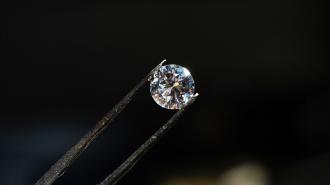South Korean researchers have developed a new technique for creating synthetic diamonds — and they think they’ve only scratched the surface of its potential.
Synthetic diamonds: Aside from jewelry, diamonds are used in drilling, manufacturing, healthcare, quantum computing, and more. The cost and uncertainty of finding the right kind of diamonds in nature inspired scientists to see if they could make them in the lab.
In the 1950s, a team at General Electric pulled it off using a process called “high-pressure high-temperature” (HPHT), which mimics the conditions that create diamonds in nature. This process is still used to make 99% of synthetic diamonds, though one called “chemical vapor deposition” (CVD), which doesn’t require high pressures, also works.
Both techniques are far faster than the natural method, producing diamonds in weeks instead of eons, but they require expensive equipment, and diamonds produced using them are typically limited in size.
“[T]his could be used to develop thin coatings of diamond on surfaces, and we use these all the time.”
Torben Daeneke
What’s new? Researchers at the Institute for Basic Science (IBS) in South Korea have announced a new way to make synthetic diamonds under ambient pressure in under three hours.
The technique starts with creating a liquid metal alloy out of four elements (gallium, iron, nickel, and silicon). The mix is then exposed to methane and hydrogen gasses at a temperature of about 1025 C (1877 F) and a pressure of 1 atm (the same as air at sea level).
Though the researchers don’t fully understand how or why, something about this combination of ingredients and conditions causes the carbon in the gasses to form a diamond film on top of the alloys, which can later be detached and applied to other surfaces.
Looking ahead: This is still early research, and more work is needed to determine how the new technique for creating synthetic diamonds compares to existing ones in terms of cost. So far, the largest of the team’s diamond films is just tens of micrometers wide, but they believe the technique is scalable, which could make it useful for many diamond applications.
“It’s quite evident that this could be used to develop thin coatings of diamond on surfaces, and we use these all the time,” Torben Daeneke, a materials chemist at RMIT University, who wasn’t involved in the study, told Chemistry World.
“You could think about using this as an anti-corrosive coating in chemical reactors, for example. … Gallium is a relatively abundant, non-toxic liquid metal and all you have to do here is place it on the surface you want to coat and flush some methane over it,” he continued.
“There are numerous intriguing avenues to explore!”
Rod Ruoff
The IBS researchers have already figured out that they can grow synthetic diamonds using the new technique and other alloys, including one where the nickel is replaced with cobalt, and they’re hopeful their work will lead to even more discoveries in diamond synthesis.
“New designs and methods for introducing carbon atoms and/or small carbon clusters into liquid metals for diamond growth will surely be important,” said lead researcher Rod Ruoff.
“The creativity and technical ingenuity of the worldwide research community seem likely to me, based on our discovery, to rapidly lead to other related approaches and experimental configurations,” he continued. “There are numerous intriguing avenues to explore!”
We’d love to hear from you! If you have a comment about this article or if you have a tip for a future Freethink story, please email us at tips@freethink.com.
